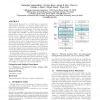Free Online Productivity Tools
i2Speak
i2Symbol
i2OCR
iTex2Img
iWeb2Print
iWeb2Shot
i2Type
iPdf2Split
iPdf2Merge
i2Bopomofo
i2Arabic
i2Style
i2Image
i2PDF
iLatex2Rtf
Sci2ools
ISPD
2010
ACM
2010
ACM
ITOP: integrating timing optimization within placement
Timing-driven placement is a critical step in nanometerscale physical synthesis. To improve design timing on a global scale, net-weight based global timing-driven placement is a commonly used technique. This paper shows that such an approach can improve timing, but often degrades wire length and routability. Another problem with existing timing-driven placers is inconsistencies in the definition of timing closure. Approaches using linear programming are forced to make assumptions about the timing models that simplify the problem. To truly do timing-driven placement, the placer must be able to make queries to a real timing analyzer with incremental capabilities. This paper describes an incremental timing-driven placer called ITOP. Using accurate timing from an industrial static timer, ITOP integrates incremental timing closure optimizations like buffering and repowering within placement to improve design timing without degrading wire length and routability. Experimental results on a ...
| Added | 17 May 2010 |
| Updated | 17 May 2010 |
| Type | Conference |
| Year | 2010 |
| Where | ISPD |
| Authors | Natarajan Viswanathan, Gi-Joon Nam, Jarrod A. Roy, Zhuo Li, Charles J. Alpert, Shyam Ramji, Chris Chu |
Comments (0)

